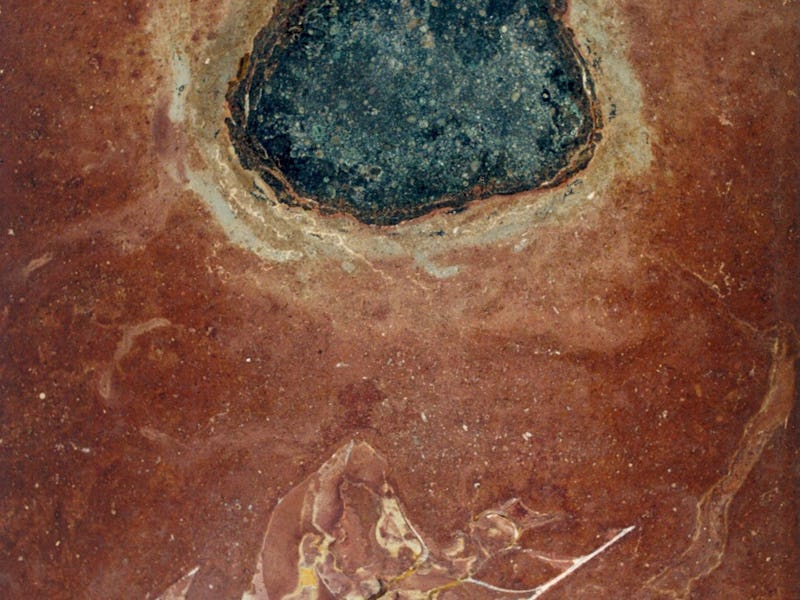Where do meteorites come from? A new study challenges popular theory
By knowing where meteorites come from, we can protect the Earth from asteroid collisions.

Geologist Birger Schmitz doesn’t just look for ordinary rocks. The Lund University professor trots the globe in search of millions or billions of year-old dust from space.
His travels have recently taken him to California, Sweden, China, and Russia, collecting 10,000 kilograms of cosmic sedimentary rock from 15 different windows of time over the past 500 million years of Earth-fallen meteorites.
Schmitz tells Inverse that the purpose of this extensive search was to trace the origins of meteorites. Instead of finding answers, though, Schmitz and his colleagues only came up with more questions. And it’s causing a re-think to the origin stories of space rocks and the history of Earth.
“That's a problem with our study, and it's a problem in science today, a big problem,” Schmitz tells Inverse. “We don't know where the meteorites that dominate the flux come from in the asteroid belt.”
The view held for years has been a simple one: that different meteorites came from different bodies in the asteroid belt and made their way to Earth. But from the evidence Schmitz collected, it seems like, improbably, most meteorites that come to Earth might be from the same parent body.
The findings of his globetrotting adventures are detailed in a study published Monday in the journal Proceedings of the National Academy of Sciences.
WHAT’S NEW — Meteorites are pieces of asteroids or comets that have broken off from their parent body and traveled through space to land on Earth.
Scientists believe that the meteorites that have fallen on Earth so far date back to major events of asteroids breaking off in space, leading to a cascade of meteorites crash landing on our planet.
But Schmitz, lead author of the new study, and his team looked at the history of asteroid collisions and compared them against asteroids as old as 500 million years. They didn’t match with any known collision event. What’s more, they seemed to come from an area of the asteroid belt that has yet to be identified.
“It’s a big conundrum, a big enigma,” Schmitz says.
After collecting rock samples, the researchers burnt away at the samples using hydrochloric acid.
After collecting one ton of rock and samples from each site, the researchers place the samples in hydrochloric acid. What is left of the sample is tiny residue, and they are then able to recover the extraterrestrial chrome-spinel grains.
Extraterrestrial chrome-spinel grains are the only common mineral found in meteorites that are known to survive long-term weathering on Earth.
“We looked for tiny, tiny needles in the big haystack,” Schmitz says. “So we basically burn the haystack.”
HERE’S THE BACKGROUND — Scientists have long theorized that meteorites were delivered to Earth by way of the cascading model, where large asteroids break apart to generate populations of new fragments that travel through the inner Solar System for an extended period of time.
Their study suggests that instead of tracing back to different asteroid break-off events, the source of the meteorites was uniform. But the authors aren't exactly sure what that source is, or how the meteorites came to land on Earth. However, a few things have been inferred:
The majority of meteorites come from a very small region of the asteroid belt.
The process that pushes them to Earth has been remarkably stable over the past 500 million years or so.
WHY IT MATTERS — Meteorites that have landed on Earth can inform us of the origin story of the Solar System and its planets.
Nicholas Castle of the Planetary Science Institute, who was not involved with the study, is interested in meteorites because he wants to understand how planets formed and evolved over time. Understanding more about these meteorites can build a picture of our origin story.
“Most meteorites date back towards the very early days of the Solar System,” Castle tells Inverse. “So that's sort of our first clues for how did we go from big gas clouds to solid material.”
Another reason is to protect our planet from a potential asteroid impact in the future by studying and identifying the different types of asteroids that pass through the Solar System.
“Meteorites tell us something about what type of objects threaten us in the future,” Schmitz says. “What type of objects do we have to be particularly aware of.”
WHAT’S NEXT — The recent study has opened up a new mystery regarding the flying space rocks that often land on Earth, and the only way to solve the mystery is by catching more of these meteorites as they make their way to our planet.
Abstract: The meteoritic material falling on Earth is believed to derive from large break-up or cratering events in the asteroid belt. The flux of extraterrestrial material would then vary in accordance with the timing of such asteroid family-forming events. In order to validate this, we investigated marine sediments representing 15 timewindows in the Phanerozoic for content of micrometeoritic relict chrome-spinel grains (>32 μm). We compare these data with the timing of the 15 largest break-up events involving chrome-spinel–bearing asteroids (S- and V-types). Unexpectedly, our Phanerozoic time windows show a stable flux dominated by ordinary chondrites similar to today’s flux. Only in the mid-Ordovician, in connection with the breakup of the L-chondrite parent body, do we observe an anomalous micrometeorite regime with a two to three orders-of-magnitude increase in the flux of L-chondritic chrome-spinel grains to Earth. This corresponds to a one order-of-magnitude excess in the number of impact craters in the mid-Ordovician following the L-chondrite break-up, the only resolvable peak in Phanerozoic cratering rates indicative of an asteroid shower. We argue that meteorites and small (<1-km-sized) asteroids impacting Earth mainly sample a very small region of orbital space in the asteroid belt. This selectiveness has been remarkably stable over the past 500 Ma.